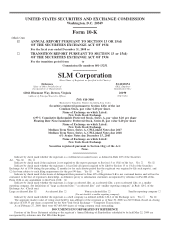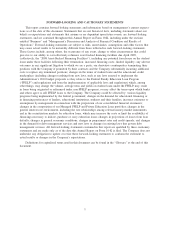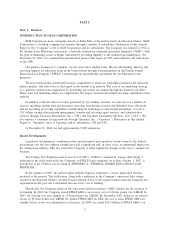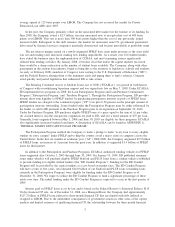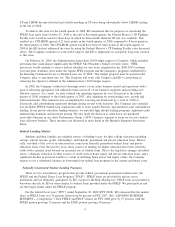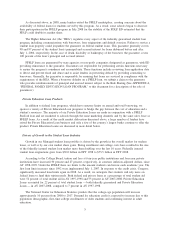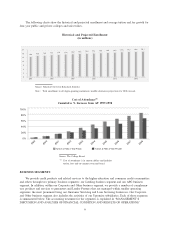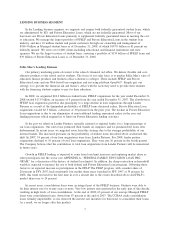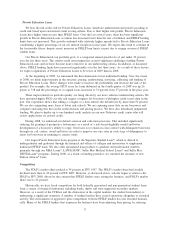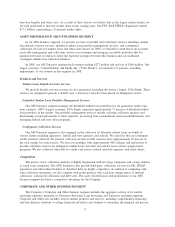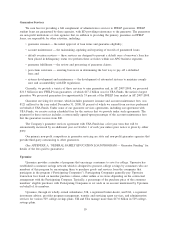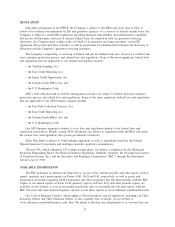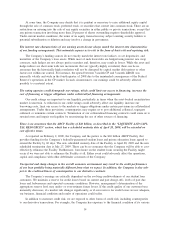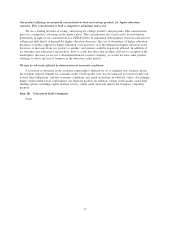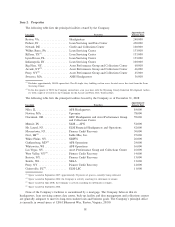Sallie Mae 2008 Annual Report Download - page 9
Download and view the complete annual report
Please find page 9 of the 2008 Sallie Mae annual report below. You can navigate through the pages in the report by either clicking on the pages listed below, or by using the keyword search tool below to find specific information within the annual report.Private Education Loans
We bear the full credit risk for Private Education Loans, which are underwritten and priced according to
credit risk based upon customized credit scoring criteria. Due to their higher risk profile, Private Education
Loans have higher interest rates than FFELP loans. Over the last several years, there has been significant
growth in Private Education Loans as tuition has increased faster than the rate of inflation and FFELP lending
limits have not increased. This growth combined with relatively higher spreads led to Private Education Loans
contributing a higher percentage of our net interest margin in recent years. We expect this trend to continue in
the foreseeable future, despite recent increases in FFELP loan limits, in part due to margin erosion of FFELP
student loans.
Our Private Education Loan portfolio grew at a compound annual growth rate of just under 30 percent
over the last three years. The current credit environment has created significant challenges funding Private
Education Loans and we have become more restrictive in our underwriting criteria. In addition, as discussed
above, FFELP lending limits have increased significantly over the last three years. As a result of these factors,
we expect originations of Private Education Loans to be lower in 2009 than in 2008.
At the beginning of 2008, we announced the discontinuation of non-traditional lending. Over the course
of 2008, we made improvements in the structure, pricing, underwriting, servicing, collecting and funding of
Private Education Loans. These changes were made to increase the profitability and decrease the risk of the
product. For example, the average FICO score for loans disbursed in the fourth quarter of 2008 was up 26
points to 738 and the percentage of co-signed loans increased to 74 percent from 57 percent in the prior year.
These improvements in portfolio quality are being driven by our more selective underwriting criteria. We
have instituted higher FICO cut-offs and require cosigners for borrowers with higher credit scores than in the
past. Our experience shows that adding a cosigner to a loan reduces the default rate by more than 50 percent.
We are also originating more loans at lower risk schools. We are capturing more data on our borrowers and
cosigners and using this data in the credit decision and pricing process. We have also introduced judgmental
lending. We plan to deploy up to one hundred credit analysts in our new Delaware credit center who will
review applications for private credit.
During 2008, we enhanced our default aversion and collection processes. This included significantly
reducing the granting of prospective forbearance as a result of a risk-based eligibility model and better
development of a borrower’s ability to repay. Our focus is to remain in close contact with delinquent borrowers
through our call centers, email and letters in order to improve our cure rates in each stage of delinquency to
assist our borrowers in returning to current status.
Our largest Private Education Loan program is the Signature Student Loan», which is offered to
undergraduates and graduates through the financial aid offices of colleges and universities to supplement
traditional FFELP loans. We also offer specialized loan products to graduate and professional students
primarily through our MBA Loans», LAWLOANS», Sallie Mae Medical School Loans»and Sallie Mae
DENTALoans»programs. During 2008, as a result of funding pressures, we curtailed the issuance of new
Tuition Answer»loans.
Competition
The FDLP’s market share peaked at 34 percent in FFY 1997. The FDLP’s market share had steadily
declined since then to 20 percent in FFY 2007. However, as discussed above, schools began to return to the
FDLP in FFY 2008, driven by the concern that FFELP lenders were exiting the business, and FDLP’s market
share rose to 24 percent.
Historically, we have faced competition for both federally guaranteed and non-guaranteed student loans
from a variety of financial institutions including banks, thrifts and state-supported secondary markets.
However, as a result of the CCRAA and the dislocation in the capital markets, the student loan industry is
undergoing a significant transition. A number of student lenders have ceased operations altogether or curtailed
activity. The environment of aggressive price competition between FFELP lenders has also lessened dramati-
cally. Many of the FFELP lenders that remain in the business have been adjusting their pricing by reducing
8

